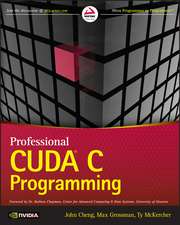Automatic Performance Prediction of Parallel Programs
Autor Thomas Fahringeren Limba Engleză Hardback – 31 mar 1996
The author introduces a novel and very practical approach for predicting some of the most important performance parameters of parallel programs, including work distribution, number of transfers, amount of data transferred, network contention, transfer time, computation time and number of cache misses. This approach is based on advanced compiler analysis that carefully examines loop iteration spaces, procedure calls, array subscript expressions, communication patterns, data distributions and optimizing code transformations at the program level; and the most important machine specific parameters including cache characteristics, communication network indices, and benchmark data for computational operations at the machine level.
The material has been fully implemented as part of P3T, which is an integrated automatic performance estimator of the Vienna Fortran Compilation System (VFCS), a state-of-the-art parallelizing compiler for Fortran77, Vienna Fortran and a subset of High Performance Fortran (HPF) programs.
A large number of experiments using realistic HPF and Vienna Fortran code examples demonstrate highly accurate performance estimates, and the ability of the described performance prediction approach to successfully guide both programmer and compiler in parallelizing and optimizing parallel programs.
A graphical user interface is described and displayed that visualizes each program source line together with the corresponding parameter values. P3T uses color-coded performance visualization to immediately identify hot spots in the parallel program. Performance data can be filtered and displayed at various levels of detail. Colors displayed by the graphical user interface are visualized in greyscale.
Automatic Performance Prediction of Parallel Programs also includes coverage of fundamental problems of automatic parallelization for distributed memory multicomputers, a description of the basic parallelization strategy and a large variety of optimizing code transformations as included under VFCS.
| Toate formatele și edițiile | Preț | Express |
|---|---|---|
| Paperback (1) | 645.47 lei 6-8 săpt. | |
| Springer Us – 26 sep 2011 | 645.47 lei 6-8 săpt. | |
| Hardback (1) | 651.75 lei 6-8 săpt. | |
| Springer Us – 31 mar 1996 | 651.75 lei 6-8 săpt. |
Preț: 651.75 lei
Preț vechi: 814.68 lei
-20% Nou
Puncte Express: 978
Preț estimativ în valută:
124.72€ • 129.43$ • 104.25£
124.72€ • 129.43$ • 104.25£
Carte tipărită la comandă
Livrare economică 15-29 martie
Preluare comenzi: 021 569.72.76
Specificații
ISBN-13: 9780792397083
ISBN-10: 0792397088
Pagini: 272
Ilustrații: XX, 272 p.
Dimensiuni: 155 x 235 x 18 mm
Greutate: 0.59 kg
Ediția:1996
Editura: Springer Us
Colecția Springer
Locul publicării:New York, NY, United States
ISBN-10: 0792397088
Pagini: 272
Ilustrații: XX, 272 p.
Dimensiuni: 155 x 235 x 18 mm
Greutate: 0.59 kg
Ediția:1996
Editura: Springer Us
Colecția Springer
Locul publicării:New York, NY, United States
Public țintă
ResearchCuprins
1 Introduction.- 1.1 Automatic Parallelization for Multiprocessor Systems.- 1.2 Motivation for Performance Prediction.- 1.3 P3T: Parameter based Performance Prediction Tool.- 1.4 Overview.- 2 Model.- 2.1 Introduction.- 2.2 Sequential Programs.- 2.3 Parallel Programs.- 2.4 Basic Parallelization Strategy.- 2.5 Optimizing Compiler Transformations.- 2.6 Using P3T and WF under VFCS.- 2.7 Summary.- 3 Sequential Program Parameters.- 3.1 Introduction.- 3.2 Sequential Program Parameters.- 3.3 Instrumentation.- 3.4 Optimization.- 3.5 Adaptation of Profile Data.- 3.6 Summary.- 4 Parallel Program Parameters.- 4.1 Introduction.- 4.2 Work Distribution.- 4.3 Number of Transfers.- 4.4 Amount of Data Transferred.- 4.5 Transfer Time.- 4.6 Network Contention.- 4.7 Number of Cache Misses.- 4.8 Computation Time.- 4.9 Summary.- 5 Experiments.- 5.1 Introduction.- 5.2 Implementation Status.- 5.3 Estimation Accuracy of P3T.- 5.4 Usefulness of P3T.- 5.5 Graphical User Interface of P3T.- 5.6 Summary.- 6 Related Work.- 6.1 Performance Prediction Techniques.- 6.2 Classification of Performance Estimators.- 7 Conclusions.- 7.1 Contributions.- 7.2 Future Research.- A Appendix.- A.1 Intersection and Volume Computation of Convex n-dimensional Polytopes.- A.2 Notation.- References.











